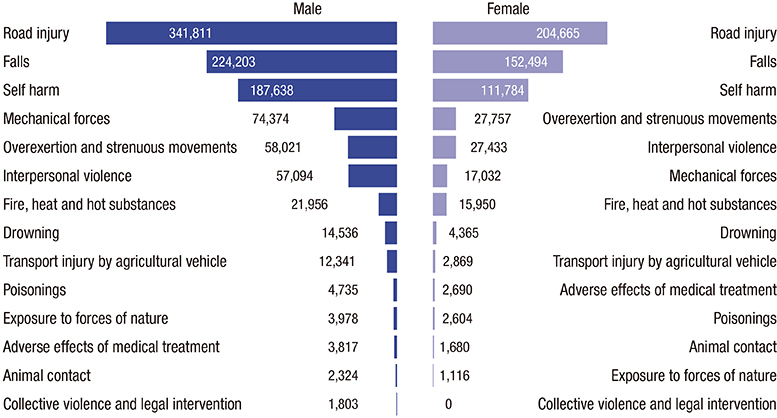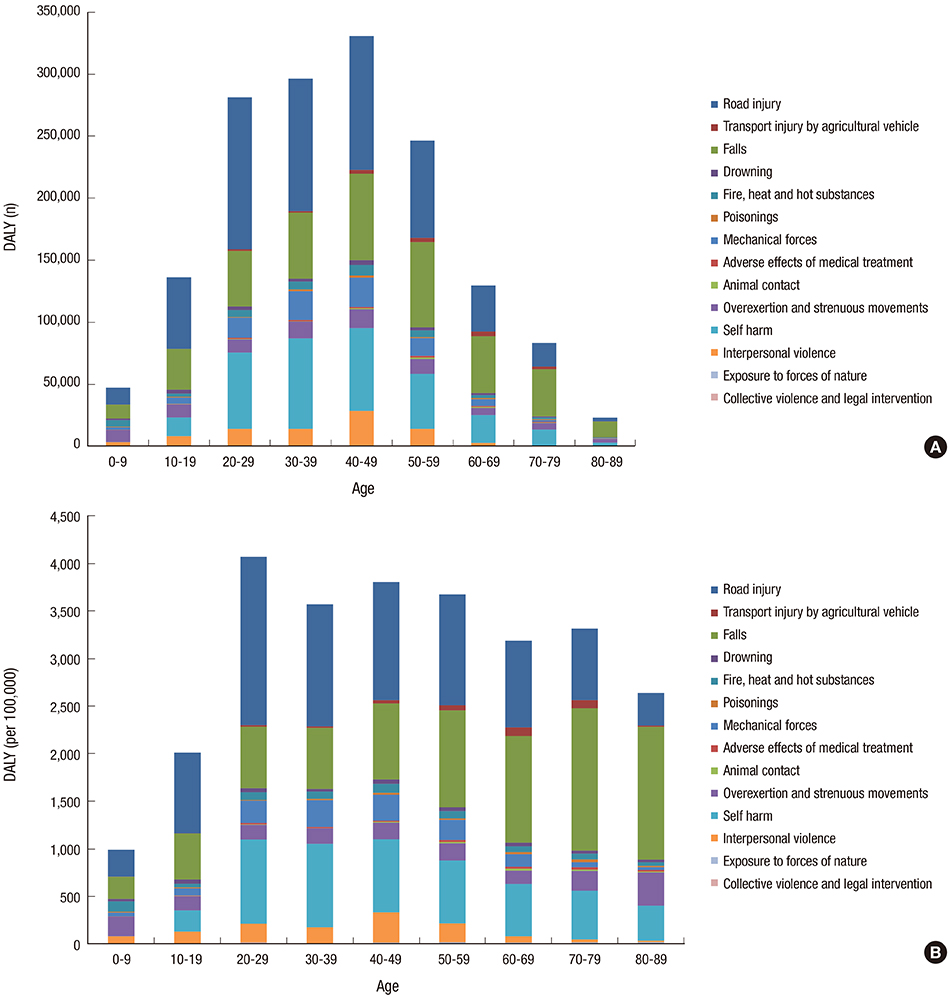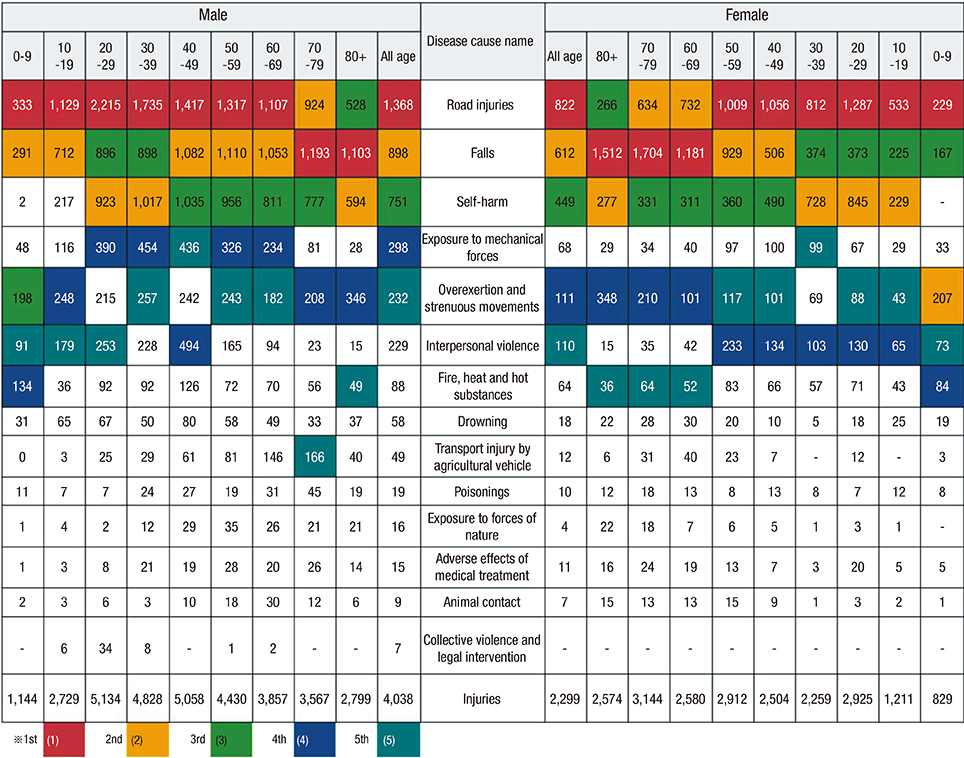Disability-Adjusted Life Years (DALYs) for Injuries Using Death Certificates and Hospital Discharge Survey by the Korean Burden of Disease Study 2012
- Affiliations
-
- 1Department of Social and Preventive Medicine, Inha University School of Medicine, Incheon, Korea.
- 2Department of Preventive Medicine, School of Medicine, Ewha Womans University, Seoul, Korea. hpark@ewha.ac.kr
- KMID: 2360671
- DOI: http://doi.org/10.3346/jkms.2016.31.S2.S200
Abstract
- A system for assessing the burdens imposed by disease and injury was developed to meet healthcare, priority setting, and policy planning needs. The first such system, the Global Burden of Disease (GBD), was implemented in 1990. However, problems associated with limited data and assumed disability weightings remain to be resolved. The purpose of the present study was to estimate national burdens of injuries in Korea using more reliable data and disability weightings. The incidences of injuries were estimated using the Korean National Hospital Discharge Survey and the mortality data from the Korean National Statistical Office in 2010. Additionally, durations of injuries and age at injury onset were used to calculate disability-adjusted life years (DALY) using disability weightings derived from the Korean Burden of Disease (KBD) study. Korea had 1,581,072 DALYs resulting from injuries (3,170 per 100,000), which was 22.9% higher than found by the GBD 2010 study. Males had almost twice as heavy an injury burden as females. Road injury, fall, and self-harm ranked 1st, 2nd, and 3rd in terms of burden of injury in 2010. Total injury burden peaked in the forties, while burden per person declined gradually from early adulthood. We hope that this study contributes to the reliable evaluation of injury burden and a better understanding of injury-related health status using nation-specific, dependable data.
Keyword
MeSH Terms
Figure
Cited by 4 articles
-
Incidence-Based versus Prevalence-Based Approaches on Measuring Disability-Adjusted Life Years for Injury
Bohyun Park, Bomi Park, Won Kyung Lee, Young-Eun Kim, Seok-Jun Yoon, Hyesook Park
J Korean Med Sci. 2019;34(Suppl 1):. doi: 10.3346/jkms.2019.34.e69.Disability Weights Measurement for 289 Causes of Disease Considering Disease Severity in Korea
Minsu Ock, Bomi Park, Hyesook Park, In-Hwan Oh, Seok-Jun Yoon, Bogeum Cho, Min-Woo Jo
J Korean Med Sci. 2019;34(Suppl 1):. doi: 10.3346/jkms.2019.34.e60.Disease-Specific Mortality and Prevalence Trends in Korea, 2002–2015
Yoonhee Shin, Bomi Park, Hye Ah Lee, Bohyun Park, Hyejin Han, Eun Jeong Choi, Nam-eun Kim, Hyesook Park
J Korean Med Sci. 2020;35(4):. doi: 10.3346/jkms.2020.35.e27.Korean National Burden of Disease: The Importance of Diabetes Management
Chung-Nyun Kim, Yoon-Sun Jung, Young-Eun Kim, Minsu Ock, Seok-Jun Yoon
Diabetes Metab J. 2024;48(4):518-530. doi: 10.4093/dmj.2024.0087.
Reference
-
1. Lozano R, Naghavi M, Foreman K, Lim S, Shibuya K, Aboyans V, Abraham J, Adair T, Aggarwal R, Ahn SY, et al. Global and regional mortality from 235 causes of death for 20 age groups in 1990 and 2010: a systematic analysis for the global burden of disease study 2010. Lancet. 2012; 380:2095–2128.2. Vos T, Flaxman AD, Naghavi M, Lozano R, Michaud C, Ezzati M, Shibuya K, Salomon JA, Abdalla S, Aboyans V, et al. Years lived with disability (YLDs) for 1160 sequelae of 289 diseases and injuries 1990-2010: a systematic analysis for the global burden of disease study 2010. Lancet. 2012; 380:2163–2196.3. Kim KS, Kim SD, Lee SH. Trend of mortality rate and injury burden of transport accidents, suicides, and falls. J Prev Med Public Health. 2012; 45:8–13.4. Khang YH. Burden of noncommunicable diseases and national strategies to control them in Korea. J Prev Med Public Health. 2013; 46:155–164.5. Centers for Disease Control and Prevention (US). Up to 40 Percent of Annual Deaths from Each of Five Leading US Causes Are Preventable. Atlanta, GA: Centers for Disease Control and Prevention;2014.6. Murray CJ, Vos T, Lozano R, Naghavi M, Flaxman AD, Michaud C, Ezzati M, Shibuya K, Salomon JA, Abdalla S, et al. Disability-adjusted life years (DALYs) for 291 diseases and injuries in 21 regions, 1990-2010: a systematic analysis for the global burden of disease study 2010. Lancet. 2012; 380:2197–2223.7. Murray CJ, Lopez AD. The Global Burden of Disease: a Comprehensive Assessment of Mortality and Disability from Diseases, Injuries and Risk Factors in 1990 and Projected to 2020 (Global Burden of disease and Injury Series Vol. 1). Cambridge, MA: Harvard University Press;1996.8. Polinder S, Haagsma J, Bos N, Panneman M, Wolt KK, Brugmans M, Weijermars W, van Beeck E. Burden of road traffic injuries: Disability-adjusted life years in relation to hospitalization and the maximum abbreviated injury scale. Accid Anal Prev. 2015; 80:193–200.9. Bao C, Mayila M, Ye Z, Wang J, Jin M, He W, Chen K. Forecasting and analyzing the disease burden of aged population in China, based on the 2010 global burden of disease study. Int J Environ Res Public Health. 2015; 12:7172–7184.10. Gilmour S, Liao Y, Bilano V, Shibuya K. Burden of disease in Japan: using national and subnational data to inform local health policy. J Prev Med Public Health. 2014; 47:136–143.11. Zhou M, Wang H, Zhu J, Chen W, Wang L, Liu S, Li Y, Wang L, Liu Y, Yin P, et al. Cause-specific mortality for 240 causes in China during 1990-2013: a systematic subnational analysis for the global burden of disease study 2013. Lancet. 2016; 387:251–272.12. Haagsma JA, Polinder S, Lyons RA, Lund J, Ditsuwan V, Prinsloo M, Veerman JL, van Beeck EF. Improved and standardized method for assessing years lived with disability after injury. Bull World Health Organ. 2012; 90:513–521.13. Lyons RA, Kendrick D, Towner EM, Christie N, Macey S, Coupland C, Gabbe BJ; UK Burden of Injuries Study Group. Measuring the population burden of injuries--implications for global and national estimates: a multi-centre prospective UK longitudinal study. PLoS Med. 2011; 8:e1001140.14. Derrett S, Samaranayaka A, Wilson S, Langley J, Ameratunga S, Cameron ID, Lilley R, Wyeth E, Davie G. Prevalence and predictors of sub-acute phase disability after injury among hospitalised and non-hospitalised groups: a longitudinal cohort study. PLoS One. 2012; 7:e44909.15. Korea Centers for Disease Control and Prevention. The 7th Korea National Hospital Discharge Survey. Cheongwon: Korea Centers for Disease Control and Prevention;2010.16. Hong J, Lee WK, Kim MK, Lee BE, Shin SD, Park H. Effect of comorbidity on length of hospital stay and in-hospital mortality among unintentionally injured patients. Accid Anal Prev. 2013; 52:44–50.17. Statistics Korea. Causes of Death Statistics in 2010. Seoul: Statistics Korea;2011.18. Barendregt JJ, Van Oortmarssen GJ, Vos T, Murray CJ. A generic model for the assessment of disease epidemiology: the computational basis of DisMod II. Popul Health Metr. 2003; 1:4.19. Lim SJ, Chung WJ, Cho WH. Economic burden of injuries in South Korea. Inj Prev. 2011; 17:291–296.20. Park K, Lee JS, Kim Y, Kim YI, Kim J. The socioeconomic cost of injuries in South Korea. J Prev Med Public Health. 2009; 42:5–11.21. Gabbe BJ, Lyons RA, Harrison JE, Rivara FP, Ameratunga S, Jolley D, Polinder S, Derrett S. Validating and improving injury burden estimates study: the injury-VIBES study protocol. Inj Prev. 2014; 20:e4.22. Lyons RA. Measuring the burden of injury. Inj Prev. 2008; 14:3–4.23. Institute for Health Metrics and Evaluation (US). Data Visualizations: GBD Compare. Seattle, WA: Institute for Health Metrics and Evaluation;2010.24. Institute for Health Metrics and Evaluation (US). Counrtry Profiles: South Korea. Seattle, WA: Institute for Health Metrics and Evaluation;2015.25. Ministry of Health and Welfare, Korea Institute for Health and Social Affairs. Patient Survey. Seoul: Korea Institute for Health and Social Affairs;2010.26. Polinder S, Meerding WJ, Mulder S, Petridou E, van Beeck E; EUROCOST Reference Group. Assessing the burden of injury in six European countries. Bull World Health Organ. 2007; 85:27–34.27. The World Bank (US). GDP Per Capita (Current US$). Washington, D.C.: The World Bank;2010.28. Institute for Health Metrics and Evaluation (US). Data Visualizations: GBD Compare. Seattle, WA: Institute for Health Metrics and Evaluation;2015.29. Ministry of Health and Welfare, Korea Centers for Disease Control and Prevention. Korea Health Statistics 2010: Korea National Health and Nutrition Examination Survey (KNHANES V-1). Cheongwon: Korea Centers for Disease Control and Prevention;2011.
- Full Text Links
- Actions
-
Cited
- CITED
-
- Close
- Share
- Similar articles
-
- Trend in Disability-Adjusted Life Years (DALYs) for Injuries in Korea: 2004–2012
- Disability-adjusted Life Years (DALYs) for Mental and Substance Use Disorders in the Korean Burden of Disease Study 2012
- Trends and Patterns of Burden of Disease and Injuries in Korea Using Disability-Adjusted Life Years
- Incidence-Based versus Prevalence-Based Approaches on Measuring Disability-Adjusted Life Years for Injury
- Measuring the Burden of Disease in Korea Using Disability-Adjusted Life Years (2008–2020)




